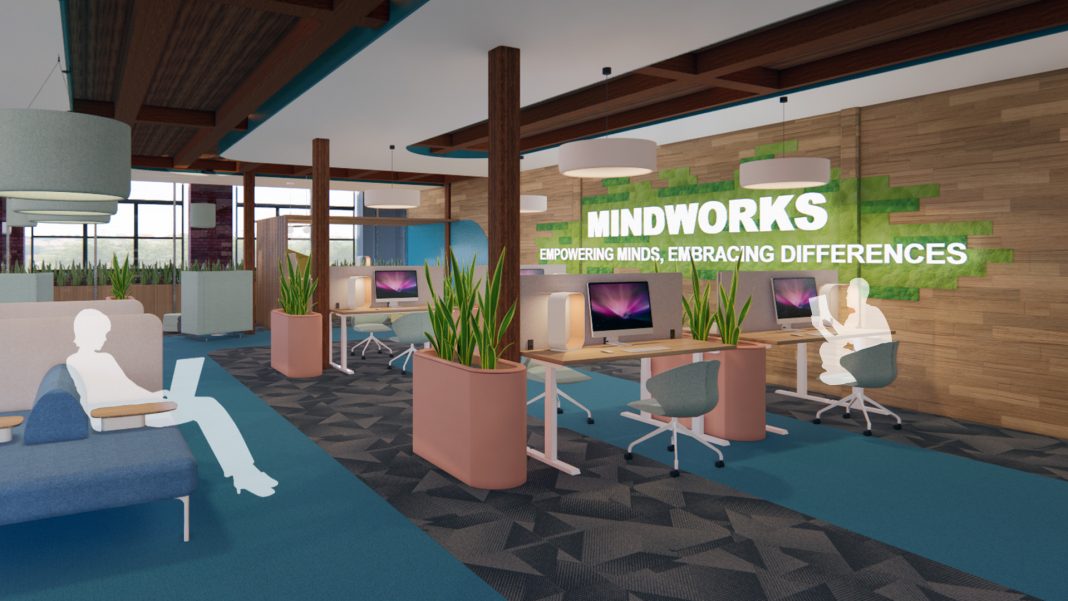Meet 2023 Next Work Environment Competition student winner Haley Giroux and her ‘MindWorks: A Neuro-Inclusive Workplace’ submission. Haley is expected to graduate from Rochester Institute of Technology with a BFA in Interior Design in 2024. She will soon be searching for opportunities that can help complete her graduate education in the Architecture Masters program. Keep up with what’s next for Haley by following her on LinkedIn and Instagram!
We connected with Haley to see how her submission has evolved since entering the competition:
Haley: Post-submission, my understanding of neuro-inclusive work spaces evolved after having discussions with potential users. I asked my neurodivergent peers, unfamiliar with interior design, to look at my microenvironments map and decide where their favorite and least favorite places to work would be. Their responses varied, but they all came to a similar critique: Central seating surrounded by circulation paths or workspaces too close to moving groups of people can be distracting and instill feelings of vulnerability. I absolutely related to that experience, and we discussed examples on campus that we found uncomfortable to work in. With this input and insight now from reading Work Design Magazine’s article, ‘Designing for Neurodiversity in the Workplace,’ I learned that the solution would be a simple incorporation of biophilic elements to aid in the visual and physical comfort, whether that be a mobile houseplant partition wall or the simple rotation of a workspace to view the vegetation outside a window.
Check out the slideshow and summary of the submission below:
MindWorks: A Neuro-Inclusive Workplace
85% of autistic (neurodiverse) adults with a college education are unemployed, according to the 2023 statistics of the U.S. Department of Labor. Why?
Employees on the spectrum can struggle to communicate in the office and are often misinterpreted, causing them to rate poorly in confidence, communication skills, and likability, which can result in self-doubting resignations. But, these misunderstood social nuances of neurodiverse workers do not mean they are incapable of producing meaningful work and value. The Harvard Business Review released a study that found that people on the spectrum are 30% more productive than their neurotypical peers if given the right environment and the right opportunities.
Neurodiverse workers, though fully capable of producing high-quality work, are struggling to connect socially in our current office environments, resulting in high turnover rates. It’s common for these workers to turn to hybrid and remote work, as they can work in the comfort of their own homes without the challenge of socializing in-person. However, these jobs pose a different risk; 40% of fully remote workers are associated with an increased likelihood of anxiety and depression symptoms, compared to in-person work, according to an analysis by the Integrated Benefits Institute. The mental health and well-being of neurodiverse workers, both at home and in-office, are struggling to find the middle ground between a healthy cognitive environment and a productive work day.
In short, 85% of educated on-the-spectrum workers are unemployed because our current office environments are not sustainable for neurodiverse people.
A Neuro-Inclusive workplace recognizes that everyone engages differently, whether on the spectrum or not, and is responsive to everyone’s emotional and cognitive needs. Active zones, or microenvironments, give users control over their preferred level of privacy, interaction, and stimulation, offering more opportunities for different communication styles to co-exist comfortably. Fidget-friendly furniture allows for continuous movement, and adjustable lighting and controlled acoustics can create that home-like comfort that remote workers are looking for. Wellness rooms and spa services allow users to decompress and self-care during their workday. These neuro-inclusive design elements can help reacclimate remote workers to in-person socializing, normalize different communication methods, and shape how we incorporate healthy conversations about inclusivity and diversity in the workplace.
MindWorks is a theoretical representation of a neuro-inclusive workplace; it features an accessible-by-membership program, self-service check-in, online day-to-day office rentals, microenvironments with varying levels of stimulation, acoustic wayfinding, and wellness centers. MindWorks Coworking Offices are located on the second and third floors of the Hungerford Building in downtown Rochester. Each floor is designed to enable two distinctive work styles; collaborative work and solo work. The second floor promotes team collaboration, socialization, conferences, online or in-person meetings, and communal dining. The third floor promotes sensory-friendly solo work, with home-like lounges, sound-proof pods, wellness centers, a members-exclusive spa, and secluded stairway access for users to comfortably adjust to the stimulation of the collaborative floor.
MindWork’s integration of traditional offices and flexible microenvironments guarantees anyone can find a workspace suitable for their specific physical and cognitive needs.


















